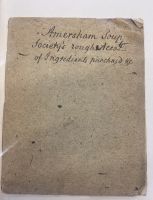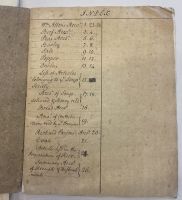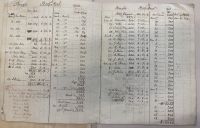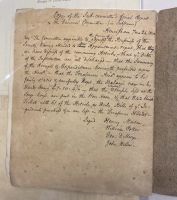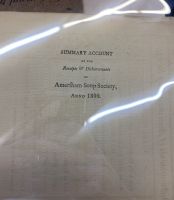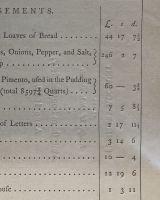Early England Soup Societies
English Soup Societies in the Early 19th Century
These documents come from a larger collection of documents about the Soup Societies in England in the early 19th century. The collection now sits in the University of Pennsylvania Kislak Center for Special Collections. The collection of documents created in late 1700’s and early 1800’s, span a range of topics relating to the soup society. These topics include blueprints of a soup kitchen, pamphlets on operations, soup recipes, account books of ingredients, schedules and more.
Historical Context
The Amersham Soup Society was a soup kitchen that opened in 1798 and stayed in operation until sometime around 1855.[1] The Spitalfields Soup Society was established in 1797 and existed into the 1960’s as a charity.[2] These soup kitchens in small towns in England were set up during a time of bad harvests which increased the price of grain and bread, making it unaffordable for many. This often led to food riots which were of particular concern given the political unrest surrounding the French Revolution at this time. These were some of the first in the history of soup kitchens which rose during the late 18th century and have now spread across the world. Additionally, this period is when the Poor Law was failing and there was serious need for reform concerning social programs and taxation in England.[3] [4]
Amersham Soup Society’s Rough Accounts of Ingredients Purchased.
-
Cover Page
-
Index
-
Beef Account Page
-
Letter on the Final Page
Overview:
- Amersham, England - 1800
- Signed by H. Morton, W. Porter, G. Dillwyn and J. Weller, but it is unclear who made all of the entries within the book
- No copyright or licensing
Physical Object:
This is a medium, handwritten codex. The cover seems to be made of a thicker, cork like material. It is full of blemishes and irregularities which suggests that the cover was added for protection more than aesthetics. This is 13 leaves folded in half to create a 26 page bifolio and it is bound with thread. The pages seem to be made from cloth. In terms of navigation, there is an index that gives the page numbers of different ingredients accounted for within the codex. Each page has a title and page number in the middle at the top of the page. The page is then split into 2 columns, “bought” on the left and “used” on the right. Each entry accounts the date, price and the quantity. On the “bought” side, it also records who made the transaction and on the “used” side it records how the ingredients were consumed.
Summary of Account of Receipts and Distribution of Amersham Soup Society
-
Title on Back
-
Summary of Accounts
-
Relief Printing
Overview:
- Amersham, England - 1800
- Printed by W. Phillips, George Yard, Lombard Street, London
- No copyright or licensing
Physical Object:
This is one large sheet of paper that is likely made of cloth. Based on the texture of the paper, this seems to have been relief printing. There is a title on the back side of the sheet that can be read when the leaf is folded along the horizontal centerline. Based on the placement of this title, it seems that the paper was meant to be folded and stored. In terms of Navigation, the paper is horizontal in landscape and it is split into two columns, “receipts” and “disbursements”. This two column method comes from development of the double-entry bookkeeping system that was introduced by Luca Pacioli of Italy. [5] Each side also has a smaller column on the right that is split into “£. s d.”, this records each entry in pounds, shillings and pence. There is also a box for the total at the bottom. The left side shows the sources of income which mostly come from “contributions”, with smaller amounts coming from the sale of soup. In total, the soup society had 397£. (This is about 45k-55k in 2023 USD). The right side shows all of the expenses such as ingredients costs, cost of coal, cook’s wages and cash. This balances against the Receipts side at 397£.
Analysis:
These accounting documents are an impressive example of the organization and dedication that those running the soup kitchen had. It is interesting to think about the motivation for these documents; why did they feel the need to keep such detailed, and even printed, records of their accounts? In this time in England, it would have been easy to simply buy ingredients, make soup and distribute it to those in need. My prediction is that these accounts were made for a few reasons. First, the size, or expected size of the kitchen. The larger the operation grew, the more important record keeping would become. Second, government reporting; it is unclear what the government's role was at the onset of these soup kitchens. It is likely that this type of record keeping would help kitchens gain government funding. This is especially important given the dialog at the time to determine what the governments relationship with charities should be. [6] Lastly, books like this could be used to prevent theft. Given the context of poverty and food shortages, people may have been motivated to steal food and this accounting measure would give the organizers a clue into the theft.
List of The Committee
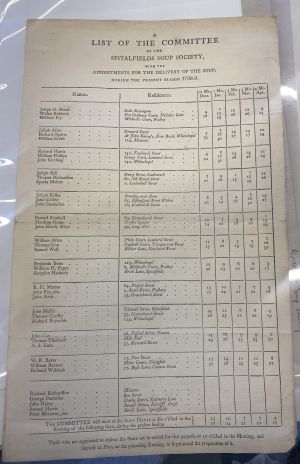
Overview:
- A list of the Committee of the Spitalfields Soup Society, with the Appointments for the Delivery of the Soup, During the Present Season 1798-9.
- Spitalfields, England - 1798
- Printed in London
- Likely published by a Committee or Head of the Committee
Physical Object:
This is one large leaf that seems to have been folded along the horizontal centerline for storage. This paper also seems to be made of cloth, as was common at the time in England. It also appears to be relief printing. In terms of navigation, this document is set up as a schedule. On the left column, names are grouped into 3, the next column lists their residences and, finally, the last columns denote when the group of 3 are to be at the soup kitchen. For example, Joseph G. Bevan, Wilson Birkbeck and William Fry were to report to the soup kitchen on December 4th and 18th, January 1st, 15th, and 29th, February 12th and 26th, ect. At the bottom on the sheet, there is a footer that states that committee members are meant to arrive at 10am on their designated days to “Deliver the Soup” and are also expected to be present at 5pm on the night before their dates to “Superintend the Preparation of it”.
Analysis:
This document speaks, again, to the dedication and organization of the soup kitchens. When thinking about the continuity of this into society today, soup kitchens often have trouble finding staff so people simply volunteer when they have time. This document shows that a group of over 30 men made a commitment to the soup kitchen. While we cannot tell from this document if the men actually showed up for their shift, their name printed on a schedule is a commitment to the task. It is also interesting to think about this being printed. It would be interesting to look for additional copies of this document to give a better understanding of how this document was consumed. If there are many copies, it’s likely that a copy was given to each committee member as a personal reference. However if this is the only copy, then it may have been posted in a central location for the committee to reference.
Extended Collection:
These three documents are a small sample of the extended collection housed in Kislak. While the documents I have selected are a good representation of the type of physical objects and publishing techniques used, the larger collection provides a much more comprehensive history of these Soup Societies. There were many other publications in the collection that were intended for distribution or for a broader audience. Overall, these Soup Societies were pioneers in the history of soup kitchens and their documentation reflects this. I speculate that the collection as a whole was referenced in the creation of later soup kitchens across England.
References
- ↑ “Soup Kitchens.” Amersham Museum, 24 Feb. 2023, https://amershammuseum.org/history/research/soup-kitchens/.
- ↑ “The Soup Kitchens of Spitalfields.” Banner, https://spitalfieldslife.com/2019/05/15/the-soup-kitchens-of-spitalfields/.
- ↑ Charity and Mutual Aid in Europe and North America Since 1800, edited by Bernard Harris, and Paul Bridgen, Taylor & Francis Group, 2007. ProQuest Ebook Central, https://ebookcentral-proquest-com.proxy.library.upenn.edu/lib/upenn-ebooks/detail.action?docID=325498.
- ↑ Relief to the Poor In the Metropolis : Minute of the Poor Law Board, Dated November 20, 1869. Marlborough, Wiltshire: Adam Matthew Digital , 2020.
- ↑ Heeffer, Albrecht. On the Curious Historical Coincidence of Algebra and Double-Entry Bookkeeping, https://logica.ugent.be/albrecht/thesis/FOTFS2008-Heeffer.pdf.
- ↑ Hawkins, James. 1870. The administration of charities. Available through: Adam Matthew, Marlborough, Poverty, Philanthropy and Social Conditions in Victorian Britain, http://www.poverty.amdigital.co.uk.proxy.library.upenn.edu/Documents/Details/FWA_110_005_b19584441.
